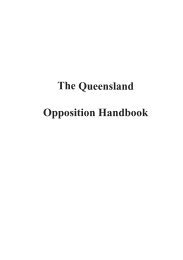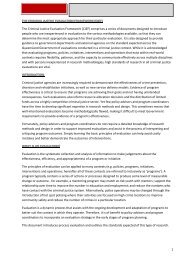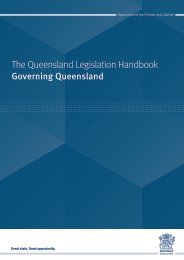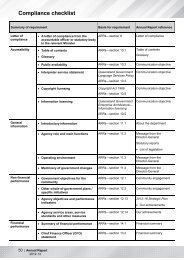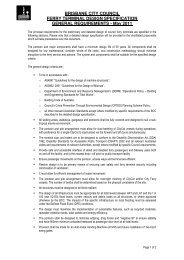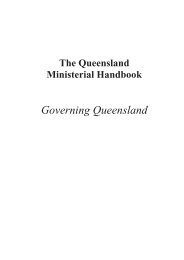Rehabilitative needs and treatment of Indigenous offenders in ...
Rehabilitative needs and treatment of Indigenous offenders in ...
Rehabilitative needs and treatment of Indigenous offenders in ...
Create successful ePaper yourself
Turn your PDF publications into a flip-book with our unique Google optimized e-Paper software.
SummaryMany <strong>of</strong> the views expressed by ISDR participants are consistent withprevious research <strong>and</strong> f<strong>in</strong>d<strong>in</strong>gs presented <strong>in</strong> this report.It is clear that ISDR participants perceived that low literacy <strong>and</strong> numeracypose a significant impediment to <strong>Indigenous</strong> <strong>of</strong>fender <strong>in</strong>volvement <strong>in</strong> QCSrehabilitative <strong>in</strong>terventions (such as crim<strong>in</strong>ogenic programs <strong>and</strong> VET) <strong>and</strong>access to health services <strong>in</strong> the community. Participants believed that thedelivery <strong>of</strong> culturally-sensitive <strong>in</strong>terventions by culturally-competent facilitatorswould <strong>in</strong>crease both the number <strong>of</strong> <strong>Indigenous</strong> persons access<strong>in</strong>grehabilitative <strong>in</strong>terventions (<strong>in</strong>clud<strong>in</strong>g literacy <strong>and</strong> numeracy courses) <strong>and</strong> theeffectiveness <strong>of</strong> these <strong>in</strong>terventions. Importantly, <strong>Indigenous</strong> <strong>of</strong>fendersexpressed an <strong>in</strong>terest <strong>in</strong> (re-)connect<strong>in</strong>g with <strong>Indigenous</strong> culture, history <strong>and</strong>heritage.It was suggested that the delivery <strong>of</strong> culturally-relevant rehabilitation<strong>in</strong>terventions could be promoted by <strong>in</strong>creas<strong>in</strong>g the number <strong>of</strong> <strong>Indigenous</strong>facilitators <strong>and</strong> improv<strong>in</strong>g the cultural-awareness <strong>of</strong> non-<strong>Indigenous</strong> <strong>of</strong>fenders.Despite positive comments regard<strong>in</strong>g the <strong>Indigenous</strong>-specific End<strong>in</strong>gOffend<strong>in</strong>g <strong>and</strong> End<strong>in</strong>g Violent Offend<strong>in</strong>g programs, participants believed that<strong>Indigenous</strong> <strong>of</strong>fenders need access to more <strong>in</strong>tensive <strong>Indigenous</strong>-specificprograms. It was also believed that <strong>Indigenous</strong> community members, such as<strong>Indigenous</strong> Elders, play a vital role <strong>in</strong> develop<strong>in</strong>g transitional l<strong>in</strong>ks for<strong>Indigenous</strong> <strong>of</strong>fenders leav<strong>in</strong>g custody. It is worth not<strong>in</strong>g that some <strong>Indigenous</strong><strong>of</strong>fenders reported that they felt shame <strong>and</strong> embarrassment when talk<strong>in</strong>gabout themselves <strong>in</strong> a group session. Other <strong>Indigenous</strong> <strong>of</strong>fenders suggestedthat one <strong>of</strong> the benefits <strong>in</strong> participat<strong>in</strong>g <strong>in</strong> <strong>Indigenous</strong>-specific programs is theability to discuss personal issues with <strong>of</strong>fenders with a similar background.The impact <strong>of</strong> colonialism <strong>and</strong> social/economic disadvantage on <strong>Indigenous</strong><strong>of</strong>fend<strong>in</strong>g was also discussed. The displacement <strong>and</strong> breakdown <strong>of</strong> familial<strong>and</strong> community networks was viewed by ISDR participants to have significantbear<strong>in</strong>g on the personal identity <strong>of</strong> <strong>Indigenous</strong> <strong>of</strong>fenders <strong>and</strong> the possibility <strong>of</strong>community-based support. The high prevalence <strong>of</strong> social <strong>and</strong> economicdisadvantage with<strong>in</strong> the <strong>Indigenous</strong> population was perceived to contribute tothe normalisation <strong>of</strong> imprisonment <strong>and</strong> high health <strong>needs</strong>. The <strong>in</strong>ability <strong>of</strong>community-based health service providers to meet the significant health<strong>needs</strong> <strong>of</strong> <strong>Indigenous</strong> communities was also highlighted. These f<strong>in</strong>d<strong>in</strong>gs drawattention to the importance <strong>of</strong> strengthen<strong>in</strong>g <strong>Indigenous</strong> communities t<strong>of</strong>acilitate their ability to support pro-social choices among <strong>Indigenous</strong><strong>of</strong>fenders after their release from custody.The research f<strong>in</strong>d<strong>in</strong>gs discussed <strong>in</strong> this chapter demonstrate that <strong>Indigenous</strong>rehabilitation requires a multi-tiered approach. This <strong>in</strong>cludes strengthen<strong>in</strong>g<strong>Indigenous</strong> <strong>in</strong>terventions with<strong>in</strong> QCS, improv<strong>in</strong>g l<strong>in</strong>ks with <strong>Indigenous</strong>communities <strong>and</strong> ensur<strong>in</strong>g the cultural-competency <strong>of</strong> non-<strong>Indigenous</strong> QCS<strong>of</strong>ficers. The need for a community-based multi-government agency approachto <strong>Indigenous</strong> <strong>of</strong>fender rehabilitation is also evident.66



